Nankhatai is a traditional cardamom-spiced Indian shortbread cookie loved by both kids and adults. A very popular snack found in most Indian bakeries, this delicious treat pairs perfectly with your evening cup of chai tea. I share two ways of making Nankhatai recipe. The traditional way with all-purpose flour and a slightly healthier version of nankhatai biscuit with whole wheat flour.

Table of Contents
What is Nankhatai
Nankhatai is a popular tea time cookie that can easily be found in most Indian bakery shops, especially during Diwali. More commonly known as Indian shortbread cookies or biscuits, nankhatai is one of those classic, nostalgic family favorite recipes that everyone loves.
I still remember my mom and her friends making these melt-in-your-mouth biscuits in the local bakery when I was younger. Growing up, even when ovens were a rarity, all the neighborhood kids would look forward to the huge trays of warm, fresh nankhatai.
Made with all-purpose flour, sugar and ghee (clarified butter), these Indian shortbread cookies have a tender, crumbly texture. They can also be made with butter and spiced with cardamom or nutmeg for a little extra flavor.
2 Recipes, Same Great Nankhatai
In this post I am sharing two different ways of how to make nankhatai. The first recipe, which is the version I prefer and recommend, is more traditional and (I think) results in a tastier cookie. The second recipe, made with whole wheat flour instead, is a bit more healthy.
- Recipe 1: Made with All Purpose Flour, Gram Flour (Besan) & Ghee
- Recipe 2: Made with Whole Wheat Flour & Butter
How to Make Nankhatai
Preparation
1. First take ½ cup sugar (100 grams) in a grinder jar.
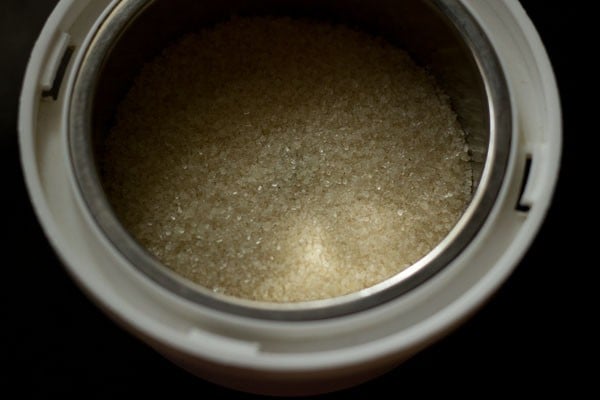
2. Then grind the sugar granules into a fine powder and set aside. At this point, go ahead and preheat the oven to 180 degrees Celsius/356 degrees Fahrenheit.

3. Now take the powdered sugar in a mixing bowl or pan. Add ⅓ to ½ cup semi solid ghee (at room temperature) or butter (at room temperature). In weight the ghee measures about 70 grams.
Make sure that the ghee is in semi-solid state and not melted or in a liquid state. It should have a grainy texture. Also do not use cold solidified ghee.
Note if using powdered sugar or confectioner’s sugar, add about ¾ cup.

4. With an electric mixer or blender, begin to cream the sugar and butter for the nankhatai dough. You can also use a food processor to do the same.
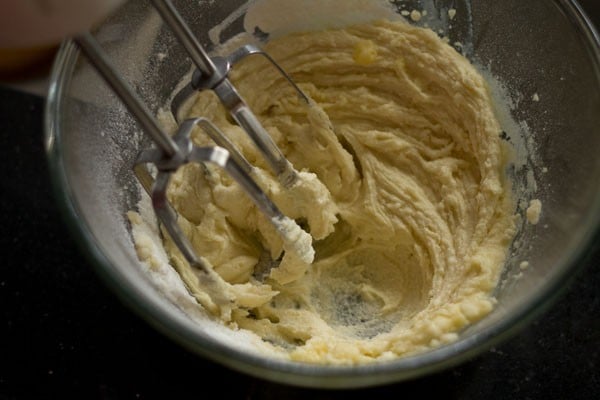
5. At this point, the mixture should become smooth, light, fluffy and creamy.

Make Nankhatai Dough
6. Now add the below listed dry ingredients to a sieve:
- 1 cup all purpose flour (125 grams)
- ⅓ cup gram flour/besan (about 40 grams)
- 1 teaspoon baking powder
- ½ teaspoon baking soda
If you do not prefer the aroma of baking soda in your cookies, then either add about ¼ teaspoon of it or choose to omit adding it.

7. Then sift the dry ingredients and set aside.

8. Then add the ½ tablespoon curd (yogurt) to the creamed ghee plus sugar.

9. Mix thoroughly.

10. Then add the sifted dry ingredients. Also add 2 tablespoon of fine rava (sooji or cream of wheat).
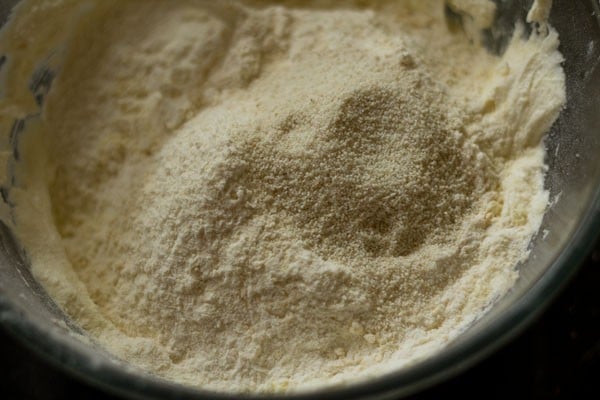
11. Now add ½ teaspoon cardamom powder and ⅛ teaspoon nutmeg powder (or grated nutmeg) to the nankhatai mixture.
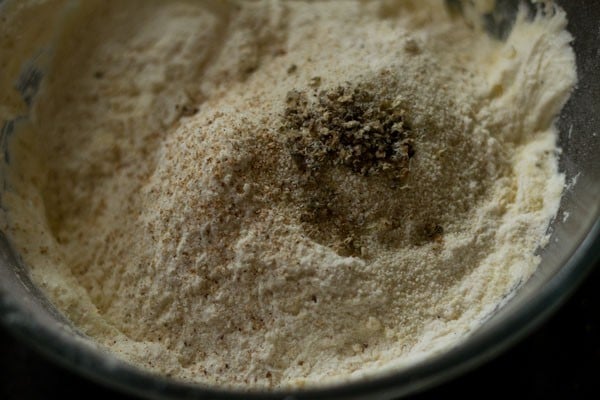
12. Begin to mix the flour with the creamed ghee with a spoon or spatula.
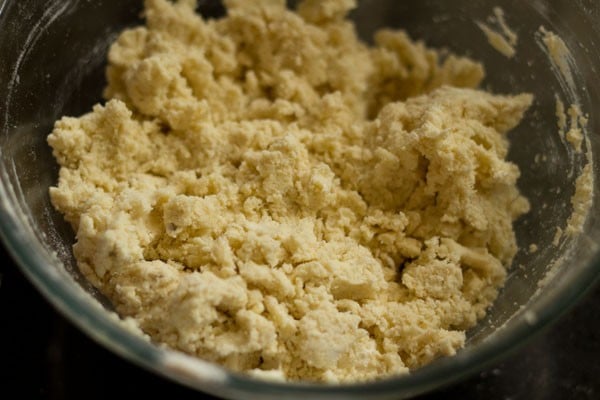
13. Gently bring together the whole mixture to a dough. If you are not able to bring together the mixture and its crumbly, then add 2 to 4 tablespoons milk which is at room temperature or cold.
Gently mix the milk with the mixture and form a dough. Do not knead the dough like you do for roti or naan dough.

Roll into Cookie Portions
14. After that, pinch medium to large sized balls from the nankhatai dough. Lightly roll them in your palms and slightly flatten them.
Place them in a baking tray. Keep some space between them as they expand and flatten while baking.
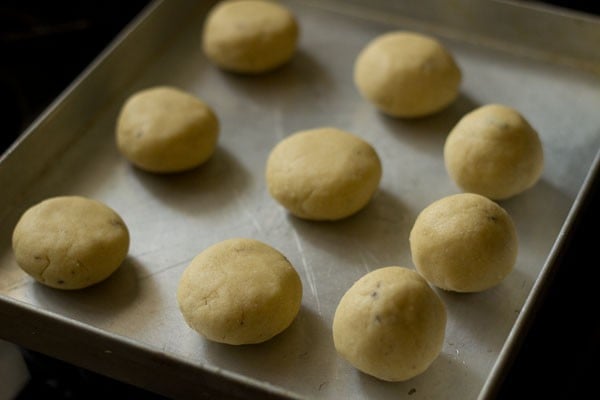
15. Optionally, you can press chironji or almonds on the top slightly. You can also make some criss cross designs on the nankhatai with a fork or toothpick.

Bake Nankhatai Biscuit
16. Finally, bake the nankhatai in a pre heated oven at 180 degrees Celsius/356 degrees Fahrenheit for 20 to 25 minutes, or until light golden or golden.
Note: Oven temperatures vary, so it may take less or more time. Make sure you keep an eye on your nankhatai while they’re baking!
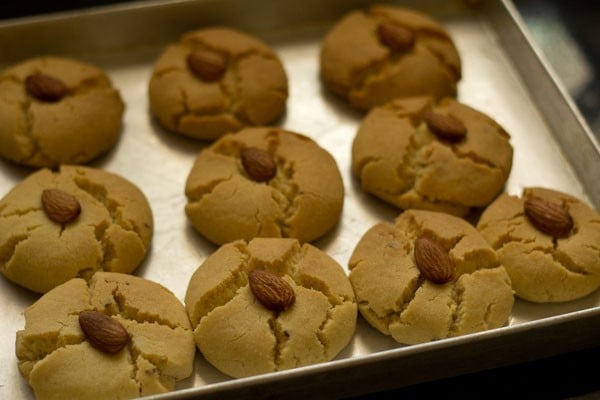
17. Keep on the baking tray for two to three minutes. Then remove the nankhatai biscuits with oven gloves on your hands and place them on wire racks to cool.
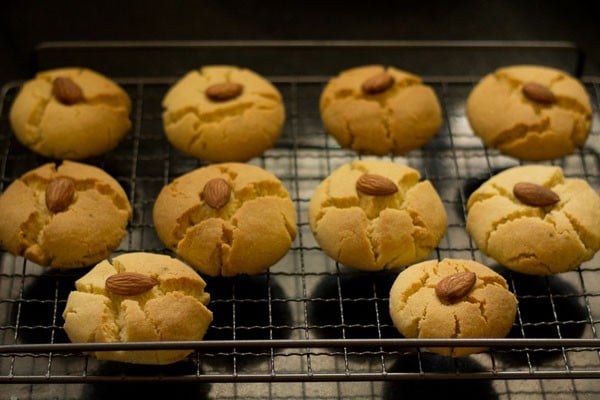
When cooled, store the nankhatai in an air tight container. These keep well for a couple of weeks in a cool dry place at room temperature.
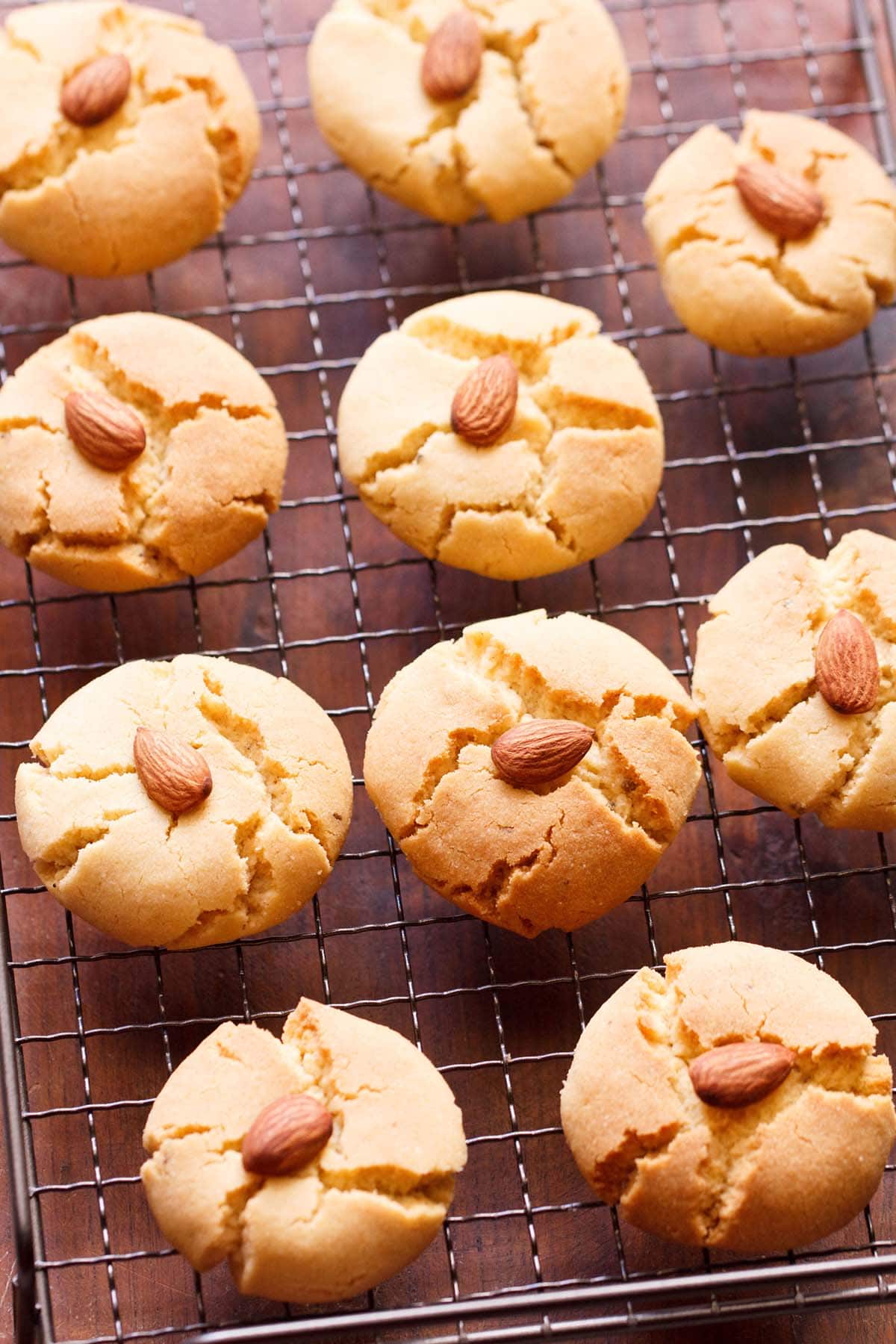
How to make Whole Wheat Nankhatai
Wherever possible, I prefer to bake cookies and cakes using whole wheat flour. These whole wheat nankhatai are not as crumbly and tender as the ones made with all-purpose flour but they taste good. They also have the nutty taste of wheat flour.
Since they are made from whole wheat flour, they are a better alternative than the one made with all-purpose flour. I have also added besan (gram flour) to give some crumbly texture.

The recipe yields 300 grams or 14 to 15 medium sized cookies. The recipe can be doubled too. Make these nankhatai biscuit this Diwali and serve them as a tea time cookie snack.
If you like baking with whole wheat flour do check my recipes of Butter Cookies and Chocolate Chip Cookies that are made with whole wheat flour.
Prep
1. In a grinder jar, take ⅓ cup sugar (70 grams), seeds from 4 to 5 green cardamoms, a pinch of saffron strands and ⅛ teaspoon grated nutmeg.

2. Grind to a fine powder. Keep aside.
If you have powdered sugar already, then use ½ cup of powdered sugar along with ½ teaspoon of cardamom powder, ⅛ teaspoon grated nutmeg and a few crushed saffron strands.

3. Grease a tray or pan very well with 1 to 2 teaspoon butter or ghee. Also preheat oven to 180 degrees Celsius/356 degrees Fahrenheit. The oven should be preheated 15 minutes before baking.
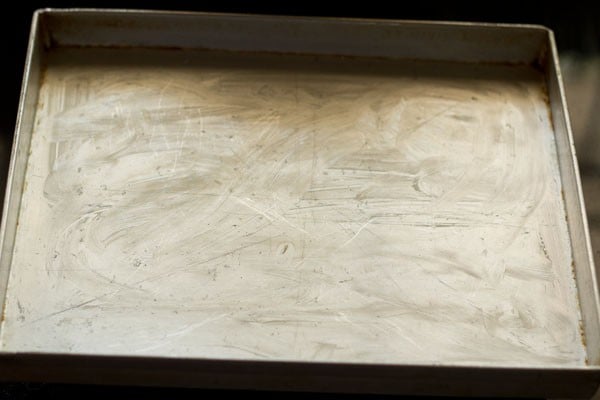
Make Dough
4. In a sieve, take 1 cup whole wheat flour (atta), 2 tablespoons gram flour (besan) and ¼ teaspoon baking soda. Add ¼ teaspoon baking powder if you do not have baking soda.
You can also add a pinch of salt at this step, if using unsalted butter or ghee. If using salted butter then skip adding salt.

5. Sift the dry mixture very well in a mixing bowl or pan.
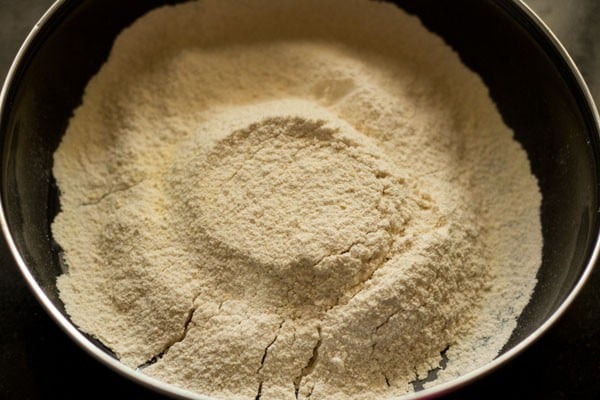
6. To the sifted flour mixture add approximate ½ cup or 70 grams of cold or chilled butter. You can also use ½ cup of ghee in semi solid state.

7. With your fingertips break the butter and mix with the flour. You can cut the butter in the flour with two knives too or with a pastry cutter.
This can also be achieved with a food processor or a stand mixer. If the butter melts while mixing with your hands, then it is fine.
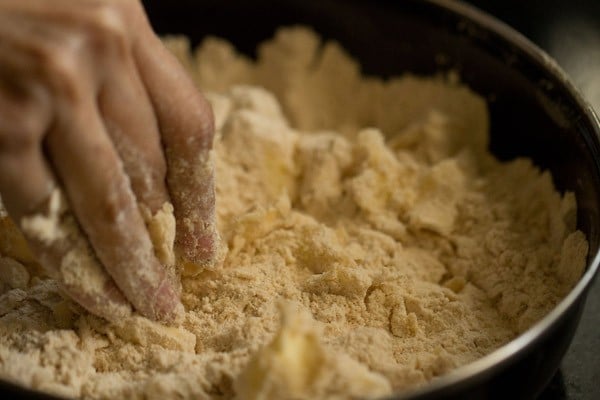
8. Mix till you get a bread crumb like texture in the mixture.
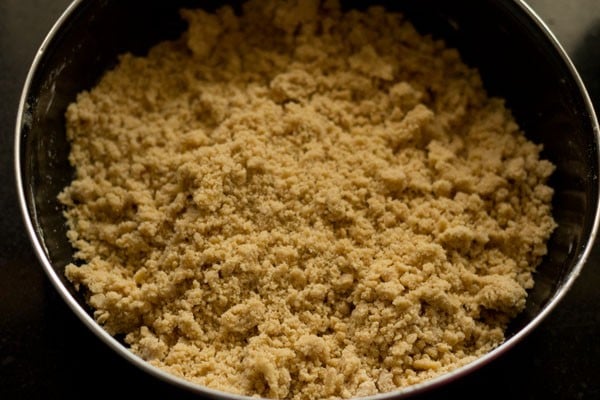
9. Now add the powdered sugar.
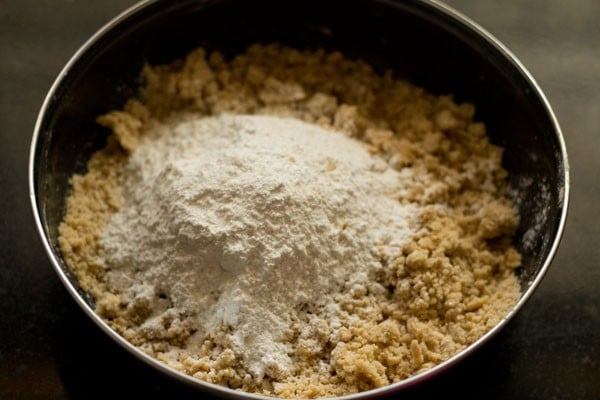
10. Lightly mix with your hands.
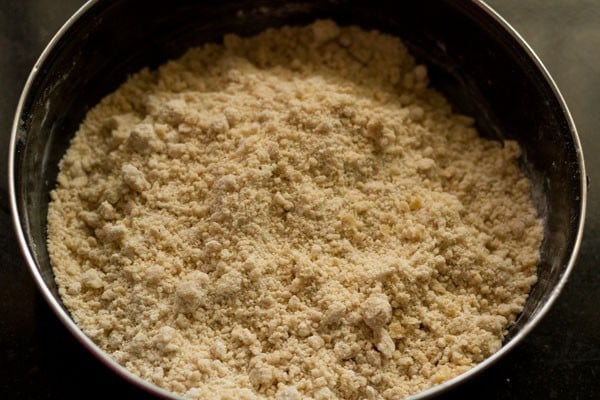
11. Add 1 to 2 tablespoons milk. The amount of milk to be added depends on the quality of flour. The mixture should be able to come together and hold easily.
If required you can also add overall 3 to 4 tablespoons of milk. I added 2 tablespoons milk. Add the milk in parts and mix.
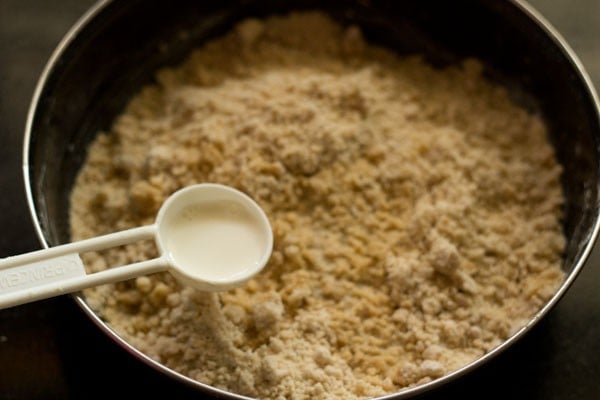
12. Gently bring together the dough into a ball.

13. Do not knead the dough. Just gently mix and gather the mixture to a dough.

14. Now pinch small or medium sized balls from the dough and lightly roll them between your palms. Place the balls on the greased baking tray.
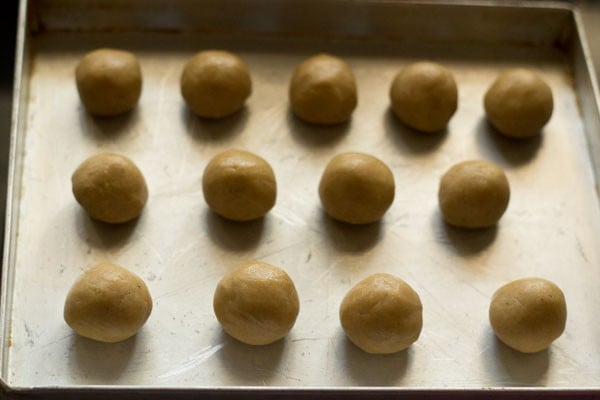
15. You can gently press them to flatten them. You can also make designs on them with a fork or toothpick.
I used a peda design maker to lightly flatten as well as to give a pattern on the top.
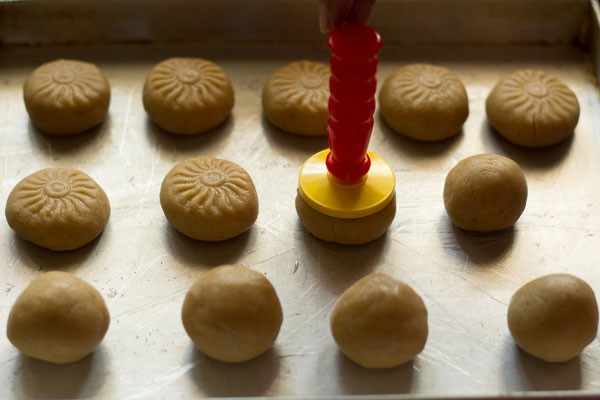
16. Here is the tray ready to go in the oven. If you want you can sprinkle and lightly press some chopped dry fruits like pistachios, almonds etc from the top.
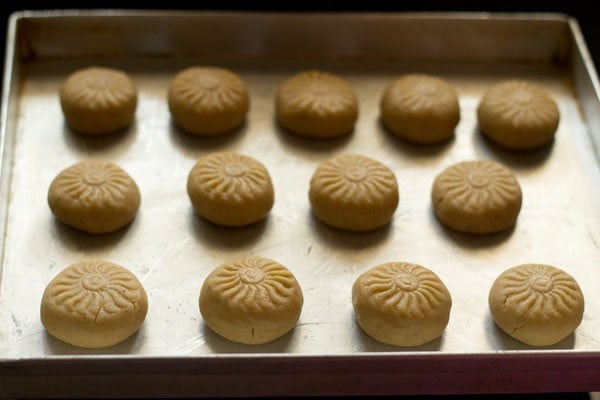
Bake Wheat Nankhatai
17. Bake in a pre heated oven at 180 degrees Celsius/356 degrees Fahrenheit for 20 to 25 mins till light golden or golden.
Since oven temperatures vary, it may takes less or more time. So do keep a check.
Once baked, after 2 to 3 minutes, remove them from the tray and keep on a wire rack for cooling.
Don’t brown them too much as then they the crust becomes too dense and hard. A light golden color on the top keeps them soft and crumbly.
For convection ovens use the preheating and baking temperature of 170 degrees Celsius/338 degrees Fahrenheit.

18. When cooled at room temperature, store them in an air tight jar. Serve whole wheat nankhatai biscuit as a tea time cookie.

Expert Tips
- Don’t leave out the besan or sooji. In these nankhatai recipe I have added some besan (gram flour) and sooji (rava or semolina). The besan gives a slight nutty taste and flavor while the sooji adds to the crispiness and crunchiness.
- Ghee consistency: The correct consistency is one the key and crucial point in making the perfect nankhatai biscuit. The ghee has to be in a semi-solid state and have a grainy or granular texture. If the ghee is completely melted or in a liquid state, keep it in the fridge for some minutes. Also remember, not to use cold solidified ghee as it will not be easy to whip.
- Do not knead the nankhatai like we do for roti dough or bread dough. Just gather the mixture to a form a cookie dough.
- More cookies, more joy! Make them in bulk and store in an airtight container to enjoy them for the next few days. Easily double or triple this recipe.
FAQs
This popular Indian snack goes perfectly with an evening cup of chai tea.
This nankhatai recipe makes 10 large nankhatai, but you can easily make small to medium shaped ones. You can also double or triple this recipe.
Yes. If you are using ready powdered sugar or confectioner’s sugar, then add ¾ cup for the traditional nankhatai recipe and ½ cup for the whole wheat nankhatai biscuit.
More Cookie Recipes to Try!
World Recipes
Sweets Recipes
Eggless Cookies & Biscuits
Eggless Cookies & Biscuits
If you’ve tried this recipe, please rate it in the recipe card or leave a comment below – I’d love to hear your feedback. For more vegetarian inspiration, sign up for my email updates or follow me on Instagram, Youtube, Facebook, Pinterest or X.
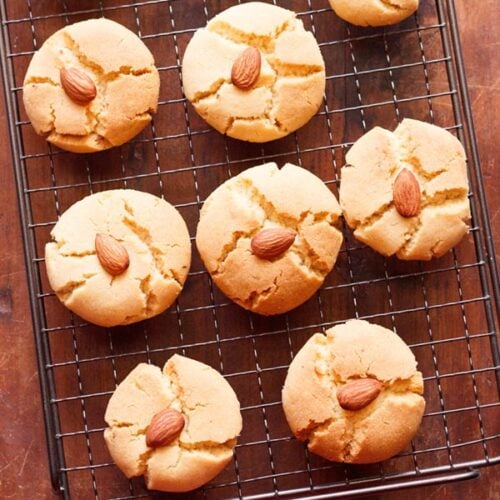
Nankhatai Recipe | Nankhatai Biscuit
Ingredients
- 1 cup all-purpose flour – 125 grams
- ⅓ cup gram flour (besan) – 40 grams
- ½ teaspoon baking soda – can add ¼ teaspoon or skip baking soda
- 1 teaspoon baking powder
- 2 tablespoons sooji (fine rava or cream of wheat) – 20 grams
- 2 to 3 pinches nutmeg powder or grated nutmeg or ⅛ teaspoon nutmeg powder
- ½ teaspoon green cardamom powder
- ⅓ to ½ cup Ghee (semi solid) or butter at room temperature, 70 grams
- ½ cup sugar 100 to 110 grams sugar or ¾ cup powdered sugar or confectioner's sugar or add as per taste
- ½ tablespoon Curd (yogurt)
- 2 to 4 tablespoons milk – at room temperature or cold
- 10 almonds or pistachios or chironji (charoli), or any preferred nuts, optional
Instructions
Preparation
- Powder the sugar finely in a grinder or spice-grinder.
- Then cream the ghee and powdered sugar with a electric mixer or blender. You can also cream in a food processor.
- The mixture should become smooth, light and creamy.
- Sift the following dry ingredients – all-purpose flour, besan (gram flour), baking powder and baking soda. Keep the sifted dry ingredients aside.
- Add curd (yogurt) to the creamed ghee and sugar mixture. Mix very well.
- Now add the sifted dry ingredients. Also add the sooji (rava or cream of wheat), cardamom powder and nutmeg powder.
- Gently mix everything. Do not knead.
- Just mix and gather to a smooth dough. If the mixture is too crumbly and you cannot bring together to a dough, then add 1 to 3 tablespoons of milk at a time. Mix lightly and bring the mixture to a dough.
Shaping Nankhatai
- Pinch medium sized balls from the dough.
- Roll them evenly in your palms. Slightly flatten them. Press chironji or almonds on the top lightly.
- You can also make some criss cross designs on the nankhatai with a fork or toothpick.
Baking Nankhatai Biscuit
- Place the nankhatai in a baking tray.
- Keep some space between them as they expand while baking.
- Bake the nankhatai in a preheated oven at 180 degrees Celsius/356 degrees Fahrenheit for 20 to 25 mins till light golden.
- Remove and place them on wire racks, so that they cool at room temperature.
- When cooled, store the nankhatai in an airtight container.
Video
Notes
Tips:
- Keep in mind not to knead the dough. Simply, combine, gather the ingredients and form a dough.
- Try to add the gram flour and rava as mentioned in the recipe. If you skip either, you will need to change the proportion of ghee and sugar.
- If you prefer, you can skip adding baking soda or add in lesser amounts.
- Ensure that the ghee is in a semi-solid state and not melted or solidified.
- As the temperatures vary in different oven models, keep an eye while baking. If the nankhatai are not baked enough then bake them for some more minutes.
- The recipe is scaleable to make a small batch or a big batch for festivals.
To make nankhatai in microwave oven
- You cannot make nankhatai in the microwave mode of the microwave oven. However if your microwave oven has convection option, then you can use the convection mode (option) to make them in the microwave oven.
- Pre heat the microwave oven in the convection mode at 170 degree celsius for 10 minutes. Then bake the nankhatai in the preheated microwave oven in the convection mode at 170 degrees celsius for 15 to 20 minutes or till light golden.
Nutrition Info (Approximate Values)
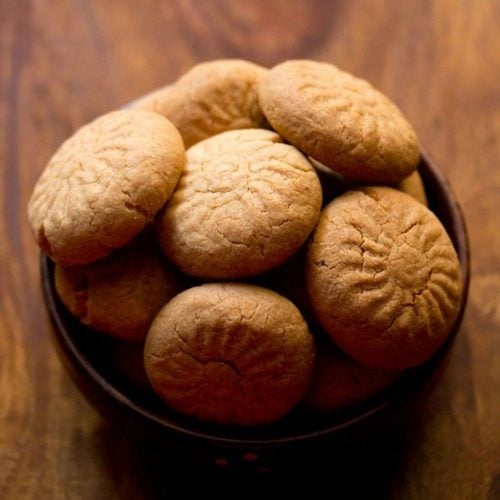
Whole Wheat Nankhatai
Ingredients
- 1 cup whole wheat flour or 125 grams
- 2 tablespoon gram flour (besan)
- ¼ teaspoon baking soda or ¼ teaspoon baking powder
- 1 pinch salt – do not add if using salted butter or ghee
- 70 grams cold salted or unsalted butter – approx ½ cup butter or 70 grams ghee in semi solid state
- ⅓ cup sugar or 70 grams sugar or 70 grams powdered sugar or approx ½ cup powdered sugar
- 4 to 5 green cardamoms – crushed lightly to remove the cover and the seeds kept
- 1 pinch saffron strands
- ⅛ teaspoon grated nutmeg or nutmeg powder
- 1 to 2 tablespoons milk
- 1 to 2 teaspoon Butter or ghee for greasing the baking tray
Instructions
Making dough
- In a grinder jar, take the sugar, seeds from 4 to 5 green cardamoms, a pinch of saffron strands and grated nutmeg.
- Grind to a fine powder. Keep aside. If you have powdered sugar already, then use ½ cup of powdered sugar.
- Grease a tray or pan very well with 1 to 2 tsp butter or ghee. Also preheat oven to 180 degrees celsius/356 degrees fahrenheit.
- In a seive, take the whole wheat flour (atta), gram flour and baking soda. Add ¼ teaspoon baking powder if you do not have baking soda.
- Sift the dry mixture very well in a mixing bowl or pan.
- To the sifted flour mixture add cold or chilled butter. You can also use ½ cup of ghee in semi-solid state.
- With your fingertips break the butter and mix with the flour. You can cut the butter in the flour with two knives too. This can also be achieved with a food processor or a stand mixer. If the butter melts while mixing with your hands, then its fine.
- Mix till you get a bread crumb like texture in the mixture.
- Now add the powdered sugar and lightly mix with your hands.
- Add 1 to 2 tablespoons milk. The amount of milk to be added depends on the quality of flour. The mixture should be able to come together and hold itself. If required you can also add overall 3 to 4 tablespoons of milk. I added 2 tablespoons of milk. Add the milk in parts and mix.
- Gently bring together the dough into a ball. Do not knead the dough. Just gently mix.
Making whole wheat nankhatai
- Now pinch small or medium-sized balls from the dough and lightly roll them. Place the balls on the greased baking tray.
- You can gently press them to flatten them. You can also make designs on them with a fork or toothpick. I used a peda design maker to lightly flatten as well as to give a pattern on the top.
- Bake them in the pre heated oven at 180 degrees c/356 degrees fahrenheit for 20 to 25 mins till light golden or golden.
- Since oven temperatures vary, it may takes less or more time. So do keep a check.
- After 2 to 3 minutes, remove them from the tray and keep on a wire rack for cooling.
- When cooled at room temperature, store in an airtight jar. Serve Whole Wheat Nankhatai as a tea time cookie.
Notes
- Remember not to knead the dough.
- If using ghee instead of butter, ensure the ghee is in a semi-solid state.
- You can also use fine jaggery powder instead of sugar in this recipe. If the jaggery powder has small granules, run it through a mixer-grinder to get a fine powder.
- The recipe can be scaled easily to make a smaller portion or a larger portions.
This Nankhatai Recipe from the archives first published in October 2013 has been republished and updated on 22 October 2022.
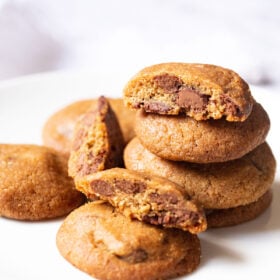
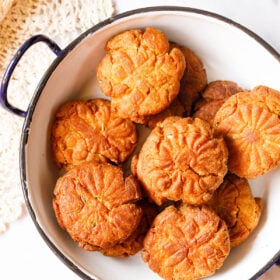

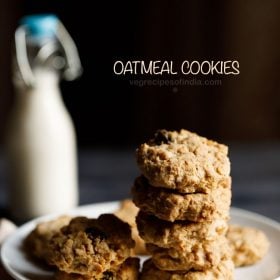










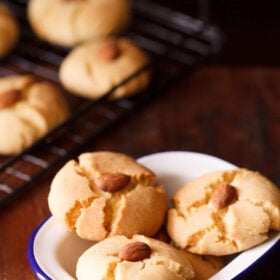
Comments are closed.